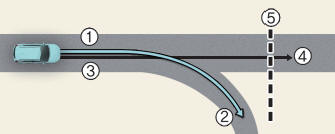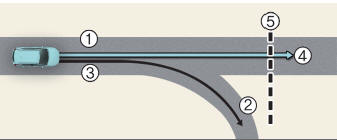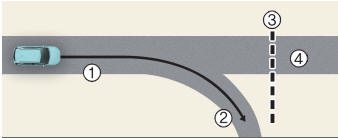KIA Niro: Limitations of Navigation-based Smart Cruise Control
KIA Niro EV, Hybrid - Second generation - (SG2) (2021-2024) - Owner's manual / Driving your vehicle / Navigation-based Smart Cruise Control (NSCC) / Limitations of Navigation-based Smart Cruise Control
Navigation-based Smart Cruise Control may not operate properly under the following circumstances:
- The navigation is not working properly
- Speed limit and road information in the navigation is not updated
- Map information is not transmitted due to infotainment system's abnormal operation
- The map information and the actual road is different because of real-time GPS data or map information error
- The navigation searches for a route while driving
- GPS signals are blocked in areas such as a tunnel
- A road that divides into two or more roads and joins again
- The driver goes off course the route set in the navigation
- The route to the destination is changed or canceled by resetting the navigation
- The vehicle enters a service station or rest area
- Android Auto or Car Play is operating
- The navigation cannot detect the current vehicle position (for example, elevated roads including overpass adjacent to general roads or nearby roads exist in a parallel way)
- The navigation is being updated while driving
- The navigation is being restarted while driving
- The speed limit of some sections changes according to the road situations
- Driving on a road under construction
- Driving on a road that is controlled
- There is bad weather, such as heavy rain, heavy snow, etc.
- Driving on a road that is sharply
curved

[1]: Set route, [2]: Branch line, [3]: Driving route, [4]: Main road, [5]: Curved road section
- When there is a difference between the navigation set route (branch line) and the driving route (main road), Highway Curve Zone Auto Slowdown function may not operate until the driving route is recognized as the main road.
- When the vehicle's driving route is
recognized as the main road by maintaining
the main road instead of the
navigation set route, Highway Curve
Zone Auto Slowdown function will
operate. Depending on the distance to
the curve and the current vehicle
speed, vehicle deceleration may not
be sufficient or may decelerate rapidly.

[1]: Main road, [2]: Branch line, [3]: Driving route, [4]: Set route, [5]: Curved road section
- When there is a difference between the navigation route (main road) and the driving route (branch line), Highway Curve Zone Auto Slowdown function will operate based on the curve information on the main road.
- When it is judged that you are driving
out of the route by entering the highway
interchange or junction, Highway
Curve Zone Auto Slowdown function
will not operate.

[1]: Driving route, [2]: Branch line, [3]: Curved road section, [4]: Main road
- If there is no destination set on the navigation, Highway Curve Zone Auto Slowdown function will operate based on the curve information on the main road.
- Even if you depart from the main road, Highway Curve Zone Auto Slowdown function may temporarily operate due to navigation information of the highway curve section.
WARNING
- Navigation-based Smart Cruise Control
is not a substitute for safe driving
practices, but a convenience function.
Always have your eyes on the road, and it is the responsibility of the driver to avoid violating traffic laws.
- The navigation's speed limit information may differ from the actual speed limit information on the road. It is the driver's responsibility to check the speed limit on the actual driving road or lane.
- Navigation-based Smart Cruise Control will automatically be canceled when you leave the highway (or motorway) main road. Always pay attention to road and driving conditions while driving.
- Navigation-based Smart Cruise Control
may not operate due to the existence
of leading vehicles and the
driving conditions of the vehicle.
Always pay attention to road and driving conditions while driving.
- When you are towing a trailer or another vehicle, turn off Navigationbased Smart Cruise Control for safety reasons.
- After you pass through a tollgate on a highway (or motorway), Navigationbased Smart Cruise Control will operate based on the first lane. If you enter one of the other lanes, Navigationbased Smart Cruise Control might not operate properly.
- The vehicle will accelerate if the driver depresses the accelerator pedal while Navigation-based Smart Cruise Control is operating, and the function will not decelerate the vehicle. However, if the accelerator pedal is depressed insufficiently, the vehicle may decelerate.
- If the driver accelerates and releases the accelerator pedal while Navigation- based Smart Cruise Control is operating, the vehicle may not decelerate sufficiently or may rapidly decelerate to a safe speed.
- If the curve is too large or too small, Navigation-based Smart Cruise Control may not operate.
- Navigation-based Smart Cruise Control is a supplemental function and is not a substitute for safe driving. It is the responsibility of the driver to always check the speed and distance to the vehicle ahead. Always drive safely and use caution.
NOTICE
- A time gap could occur between the navigation's guidance and when Navigation- based Smart Cruise Control operation starts and ends.
- The speed information on the cluster and navigation may differ.
- Even if you are driving at a speed lower than Smart Cruise Control set speed, acceleration may be limited by the curve sections ahead.
- If Navigation-based Smart Cruise Control is operating while leaving the main road to enter an interchange, junction, rest area, etc., the function may operate for a certain period of time.
- Deceleration by Navigation-based Smart Cruise Control may feel it is not sufficient due to road conditions such as uneven road surfaces, narrow lanes, etc.
READ NEXT:
 Lane Following Assist settings
Lane Following Assist settings
Lane Following Assist is designed to help
detect lane markings and/or vehicles on
the road, and assists the driver's steering
to help center the vehicle in the lane.
Detecting sensor
Front view camera
The front view camera is used as a
 Lane Following Assist operation
Lane Following Assist operation
Turning Lane Following Assist On/Off
With the engine on, shortly press the
Lane Driving Assist button located on
the steering wheel to turn on Lane Following
Assist. The grey or green ( )
indicator light will appear on the cluster.
Press
SEE MORE:
 Curtain Airbag (CAB)
Curtain Airbag (CAB)
Description
Curtain airbags are installed inside the headliner (LH and RH) and protect
the driver and passenger
from danger when side crash occurs. The SRSCM determines deployment of curtain
airbag by using
side impact sensor (SIS) signal.
Wa
 Accelerator Position Sensor (APS)
Accelerator Position Sensor (APS)
Specification
Accelerator Position Sensor (APS) Description and operation
Description
Installed on the accelerator pedal module, the Accelerator Position Sensor (APS)
detects the rotation
angle of the accelerator pedal. The APS is one o
Categories
- Home
- KIA Niro EV, Hybrid - Second generation - (SG2) (2021-2024) - Owner's manual
- Kia Niro - First generation - (DE) (2017-2022) - Service and Repair Manual
- Contact Us
